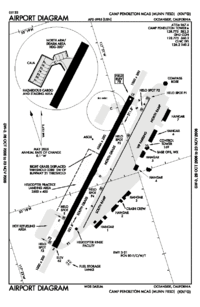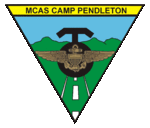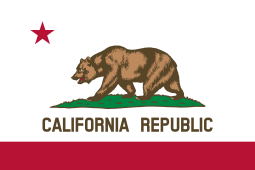Marine Corps Air Station Camp Pendleton
Coordinates: 33°18′04″N 117°21′19″W / 33.30111°N 117.35528°W
| MCAS Camp Pendleton Munn Field | |||||||||||||||||||||||||||||||
|---|---|---|---|---|---|---|---|---|---|---|---|---|---|---|---|---|---|---|---|---|---|---|---|---|---|---|---|---|---|---|---|
|
MCAS Camp Pendleton insignia | |||||||||||||||||||||||||||||||
| IATA: none – ICAO: KNFG – FAA LID: NFG | |||||||||||||||||||||||||||||||
| Summary | |||||||||||||||||||||||||||||||
| Airport type | Military | ||||||||||||||||||||||||||||||
| Operator | United States Marine Corps | ||||||||||||||||||||||||||||||
| Serves | MCB Camp Pendleton | ||||||||||||||||||||||||||||||
| Location | Oceanside, California | ||||||||||||||||||||||||||||||
| Built | 1942 | ||||||||||||||||||||||||||||||
| In use | 1942 - present | ||||||||||||||||||||||||||||||
| Commander | Col. Ian R. Clark | ||||||||||||||||||||||||||||||
| Occupants | Marine Aircraft Group 39 | ||||||||||||||||||||||||||||||
| Elevation AMSL | 78 ft / 24 m | ||||||||||||||||||||||||||||||
| Website | www.mcaspendleton.marines.mil | ||||||||||||||||||||||||||||||
| Runways | |||||||||||||||||||||||||||||||
| |||||||||||||||||||||||||||||||
| Helipads | |||||||||||||||||||||||||||||||
| |||||||||||||||||||||||||||||||

Marine Corps Air Station Camp Pendleton or MCAS Camp Pendleton (ICAO: KNFG, FAA LID: NFG) is a United States Marine Corps airfield located within Marine Corps Base Camp Pendleton, California. It was commissioned in 1942 and is currently home to Marine Aircraft Group 39. The airfield is also known as Munn Field in honor of Lieutenant General John C. "Toby" Munn, the first Marine Aviator to serve as the Commanding General of Marine Corps Base Camp Pendleton.
Tenant commands
History
On September 25, 1942, the area presently known as Marine Corps Air Station, Camp Pendleton, California was designated an auxiliary landing field and served as a sub-unit of Marine Corps Air Station El Toro.[3] The airfield was 6,000 ft by 400 ft and began operating in November 1942. In February 1944, it became an Outlying Field (OLF) to Marine Corps Auxiliary Field Gillespie and it was during this time that the first squadrons were actually assigned to the field. Among the first squadrons were VMO-5, VMF-323 and VMF-471. In September 1944, the field was designated as a permanent establishment. In 1945, due to overcrowding at Marine Corps Air Station El Centro, Marine Aircraft Group 35 began parking its spare transport planes at the field as well.[4]
During the early 1950s, the airfield was used for the filming of The Flying Leathernecks starring John Wayne.
Marine Observation Squadron FIVE (VMO-5), a composite squadron consisting of both OV-10 Bronco fixed-wing aircraft and UH-1 Huey helicopters, was established in 1966 and was the first squadron stationed at the airfield following World War II.
Through the years, aviation began to play an increasing role in Marine Corps tactics, creating a need for modern facilities. To meet this need, the auxiliary landing field was re-designated a Marine Corps Air Facility (MCAF) on September 1, 1978 serving as home to Marine Aircraft Group 39 (MAG-39). Since 1978, the Group expanded to a strength of four tactical helicopter squadrons, one helicopter training squadron, one observation squadron, and an aviation logistics squadron. This increase in aircraft and personnel established once again the need for improved facilities.
On March 13, 1985, MCAF Pendleton was re-designated as Marine Corps Air Station effective April 1, 1985. Today, the Air Station supports over 180 helicopters assigned to MAG-39, Marine Aircraft Group 46 Detachment A, and a wide variety of other Marine Corps units and visiting aircraft from other branches of the Armed Forces. The closure of MCAS Tustin and MCAS El Toro were a result of Base Realignment and Closure legislation which saw MCAS Camp Pendleton expand its facilities again to support three additional helicopter squadrons. The first medium lift helicopter squadron joined MAG-39 in January 1999, and the final one came in June of that same year.
See also
- List of airports in California
- List of United States Marine Corps installations
- United States Marine Corps Aviation
References
- Notes
![]() This article incorporates public domain material from websites or documents of the United States Marine Corps.
This article incorporates public domain material from websites or documents of the United States Marine Corps.
- ↑ MCAS Camp Pendleton, official website, retrieved 2007-11-12
- ↑ FAA Airport Master Record for NFG (Form 5010 PDF), effective 2007-10-25
- ↑ O'Hara (2005): 95
- ↑ Shettle (2001): 84
- Bibliography
- "History - MCAS Pendleton". MCAS Pendleton, United States Marine Corps. Archived from the original on 2007-02-03. Retrieved 2007-02-09.
- O'Hara, Thomas (2005). Images of America - Camp Pendleton. Charleston, SC: Arcadia. ISBN 0-7385-2982-6.
- Shettle Jr., M. L. (2001). United States Marine Corps Air Stations of World War II. Bowersville, Georgia: Schaertel Publishing Co. ISBN 0-9643388-2-3.
- Web
External links
- MCAS Camp Pendleton's official website
- Marine Corps Community Services at Camp Pendleton
- Camp Pendleton at GlobalSecurity.org
- USMC Air Station Camp Pendleton Overview & PCS Information (MarineCorpsUSA.org)
- FAA Airport Diagram (PDF), effective December 8, 2016
- Resources for this U.S. military airport:
- FAA airport information for NFG
- AirNav airport information for KNFG
- NOAA/NWS latest weather observations
- SkyVector aeronautical chart for KNFG
- Airport information for KNFG at Great Circle Mapper.
| Wikimedia Commons has media related to Marine Corps Base Camp Pendleton. |


